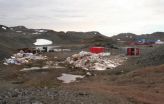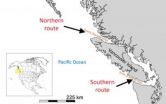(Press-News.org) This press release is available in German.
(Jena) On their mission to the moon in 1969 the Americans Neil Armstrong and Buzz Aldrin created arguably the most famous footprints ever. Since the time the astronauts of the Apollo 11 Mission stepped onto the surface of our satellite their footprints remain almost unchanged. And as no breath of wind will ever be able to blow them away they will be visible forever.
Not quite so old but equally 'immortal' are many traces that have been left behind by humans at the South Pole of the Earth. This is the result of a report on the 'Current Ecological Situation of the Fildes Peninsula Region and Management Suggestions': The report, written and published by scientists of the Friedrich Schiller University Jena (Germany), has been commissioned by the Federal Environment Agency (Umweltbundesamt). According to their findings, the environment of the Antarctic is by far less intact than many people might think: Tracks of car tires and tire chains have ploughed the sparse vegetation for kilometer after kilometer. Leftovers from derelict experimental set-ups and field huts are slowly decomposing. Rubbish – some of it containing dangerous chemicals, discarded oil cans and car batteries – is lying in the open. On top of this there are coastal waters and beaches suffering oil-pollution as a result of poor handling of fuel at the stations.
"We have a genuine waste problem in the Antarctic," says Dr. Hans-Ulrich Peter of the University Jena who was in charge writing the report. Most of all this concerns King George Island, about 120 kilometers off the Antarctic Continent. It is there, more precisely on the Fildes Peninsula, where the ecologist has been doing research on a regular basis since 1983 and meticulously documented the changes in the environment. "The Fildes Peninsula is one of the largest ice-free areas of the Antarctic with a relatively high degree of biodiversity," Dr. Peter says. As a result the region has attracted a lot of scientific interest, along with the building of six permanently occupied stations including an aircraft runway concentrated in a relatively small area, which turned it into the logistic hub of the international Antarctic research – with all consequences of permanent human settlement. In this context ecologists of the University Jena noticed that during the last thirty years not only the global climate change can be gravely felt in the Antarctic, natural life is equally threatened by the influence of human beings on the local environment of the south polar region. "Due to the extreme climatic conditions the sensitive vegetation only recovers very slowly," Christina Braun, a member of Dr. Peter's team, says. She has visited King George Island seven times already for research purposes. "Vehicle tracks sometimes remain there for decades." But the vegetation is not only damaged by vehicles and building work. According to Christina Braun the unique flora of the Antarctic is equally threatened by 'imported' plants. "Some years ago we found some non-native plants nearby the Russian research station Bellingshausen." Insects and other animal and plant species inadvertently imported by participants of expedition present dangers for the ecosystem.
"If there isn't a profound change of direction, these negative environmental influences will be amplified in the next few years," Hans-Ulrich Peter says. Therefore in approximately 130 pages of their report the German ecologists make specific suggestions for the management of this sensitive region: The crucial point is the designation of the Fildes Peninsula as an 'Antarctic Specially Managed Area' (ASMA). With this specific administrative instrument legally binding standards concerning the use of the region would be determined. The proposed measure could reduce the conflicting interests between science, tourism and the protection of geological and historical sites as well as keeping its environment intact. However, Dr. Peter regrets that the lack of consensus among the Antarctic Treaty states is blocking the realization of the proposal so far.
INFORMATION:
The complete report in English can be downloaded here: http://www.umweltdaten.de/publikationen/fpdf-l/4424.pdf.
Contact:
Dr. Hans-Ulrich Peter, Christina Braun
Institute of Ecology
Friedrich Schiller University Jena
Dornburger Straße 159
D-07743 Jena
Phone: 49-0-3641 / 949415
Email: hans-ulrich.peter[at]uni-jena.de, christina.braun77[at]gmx.de
Waste dump at the end of the world
Ecologists of Jena University (Germany) propose managing strategies to protect the Antarctic
2013-02-07
ELSE PRESS RELEASES FROM THIS DATE:
Lancet Oncology: Long-term side-effects of targeted therapies in pediatric cancer patients
2013-02-07
A University of Colorado Cancer Center review published this week in the journal Lancet Oncology describes possible long-term side-effects of new, targeted therapies in pediatric cancer patients: what we don't know may hurt us.
"As pediatricians who treat kids with cancer, we expect the side-effects of traditional chemotherapies: low white blood count, infections, even long-term heart trouble or infertility. But there's the impression that these new, molecularly targeted agents are much less toxic. That may be true, especially in adult patients, but until we have more ...
Poll: Americans back climate change regulation, not taxes
2013-02-07
DURHAM, N.C. -- Now that President Obama has put climate change back on the table in his second inaugural address, a new national poll finds growing public support for regulating greenhouse gas emissions and requiring utilities to switch to lower-carbon fuel sources.
The percentage of Americans who think climate change is occurring has rebounded, according to the Duke University national online survey, and is at its highest level since 2006. The study also finds that while Americans support regulating greenhouse gas emissions, they do not favor market-based approaches ...
Scientists discover how the world's saltiest pond gets its salt
2013-02-07
VIDEO:
Antarctica's Don Juan Pond, the world's saltiest body of water, needs its salt to keep from freezing into oblivion. Scientists had assumed that the saltwater brine that sustains the pond...
Click here for more information.
PROVIDENCE, R.I. [Brown University] — Antarctica's Don Juan Pond might be the unlikeliest body of water on Earth. Situated in the frigid McMurdo Dry Valleys, only the pond's high salt content — by far the highest of any body of water on the planet — ...
Subcortical damage is 'primary cause' of neurological deficits after 'awake craniotomy'
2013-02-07
Philadelphia, Pa. (February 7, 2013) – Injury to the subcortical structures of the inner brain is a major contributor to worsening neurological abnormalities after "awake craniotomy" for brain tumors, reports a study in the February issue of Neurosurgery, official journal of the Congress of Neurological Surgeons. The journal is published by Lippincott Williams & Wilkins, a part of Wolters Kluwer Health.
During a procedure intended to protect critical functional areas in the outer brain (cortex), damage to subcortical areas—which may be detectable on MRI scans—is a major ...
No increase in brain aneurysm rupture risk during pregnancy and delivery
2013-02-07
Philadelphia, Pa. (February 7, 2013) – For women with aneurysms involving the brain blood vessels, pregnancy and delivery don't appear to increase the risk of aneurysm rupture, reports a paper in the February issue of Neurosurgery, official journal of the Congress of Neurological Surgeons. The journal is published by Lippincott Williams & Wilkins, a part of Wolters Kluwer Health.
The study also finds that women with known, unruptured aneurysms have a very high rate of cesarean delivery—which isn't supported by evidence and "may not be necessary," according to Dr. Brian ...
NASA sees the sun produce 2 CMEs
2013-02-07
In the evening of Feb. 5, 2013, the sun erupted with two coronal mass ejections or CMEs that may glance near-Earth space. Experimental NASA research models, based on observations from the Solar Terrestrial Relations Observatory (STEREO) and ESA/NASA's Solar and Heliospheric Observatory, show that the first CME began at 7 p.m. EST and left the sun at speeds of around 750 miles per second. The second CME began at 10:36 p.m. EST and left the sun at speeds of around 350 miles per second. Historically, CMEs of this speed and direction have been benign.
Not to be confused with ...
Animal magnetism: First evidence that magnetism helps salmon find home
2013-02-07
When migrating, sockeye salmon typically swim up to 4,000 miles into the ocean and then, years later, navigate back to the upstream reaches of the rivers in which they were born to spawn their young. Scientists, the fishing community and lay people have long wondered how salmon find their way to their home rivers over such epic distances.
How do they do that?
A new study, published in this week's issue of Current Biology and partly funded by the National Science Foundation, suggests that salmon find their home rivers by sensing the rivers' unique magnetic signature. ...
NASA scientists build first-ever wide-field X-ray imager
2013-02-07
Three NASA scientists teamed up to develop and demonstrate NASA's first wide-field-of-view soft X-ray camera for studying "charge exchange," a poorly understood phenomenon that occurs when the solar wind collides with Earth's exosphere and neutral gas in interplanetary space.
The unique collaboration involved heliophysics, astrophysics and planetary science divisions at NASA's Goddard Space Flight Center in Greenbelt, Md., and resulted in the first successful demonstration of the Sheath Transport Observer for the Redistribution of Mass (STORM) instrument and a never-before-flown ...
Same factors influence depression in stroke patients, spouse caregivers
2013-02-07
Self-esteem, optimism and perceived control influence depression in stroke survivors and their spouse caregivers — who should be treated together, according to research presented at the American Stroke Association's International Stroke Conference 2013.
Researchers, who analyzed 112 depressed stroke survivors up to 8 weeks after hospital discharge and their spouses, found self-esteem and optimism influenced each partners' depression.
"We usually have been focused on the outcome of the stroke survivor, but we found that the self-esteem and optimism of the spouse caretaker ...
Study: Number of people with Alzheimer's disease may triple by 2050
2013-02-07
MINNEAPOLIS – The number of people with Alzheimer's disease is expected to triple in the next 40 years, according to a new study published in the February 6, 2013, online issue of Neurology®, the medical journal of the American Academy of Neurology.
"This increase is due to an aging baby boom generation. It will place a huge burden on society, disabling more people who develop the disease, challenging their caregivers, and straining medical and social safety nets," said co-author Jennifer Weuve, MPH, ScD, assistant professor of medicine, Rush Institute for Healthy Aging ...
LAST 30 PRESS RELEASES:
Making lighter work of calculating fluid and heat flow
Normalizing blood sugar can halve heart attack risk
Lowering blood sugar cuts heart attack risk in people with prediabetes
Study links genetic variants to risk of blinding eye disease in premature infants
Non-opioid ‘pain sponge’ therapy halts cartilage degeneration and relieves chronic pain
AI can pick up cultural values by mimicking how kids learn
China’s ecological redlines offer fast track to 30 x 30 global conservation goal
Invisible indoor threats: emerging household contaminants and their growing risks to human health
Adding antibody treatment to chemo boosts outcomes for children with rare cancer
Germline pathogenic variants among women without a history of breast cancer
Tanning beds triple melanoma risk, potentially causing broad DNA damage
Unique bond identified as key to viral infection speed
Indoor tanning makes youthful skin much older on a genetic level
Mouse model sheds new light on the causes and potential solutions to human GI problems linked to muscular dystrophy
The Journal of Nuclear Medicine ahead-of-print tip sheet: December 12, 2025
Smarter tools for peering into the microscopic world
Applications open for funding to conduct research in the Kinsey Institute archives
Global measure underestimates the severity of food insecurity
Child survivors of critical illness are missing out on timely follow up care
Risk-based vs annual breast cancer screening / the WISDOM randomized clinical trial
University of Toronto launches Electric Vehicle Innovation Ontario to accelerate advanced EV technologies and build Canada’s innovation advantage
Early relapse predicts poor outcomes in aggressive blood cancer
American College of Lifestyle Medicine applauds two CMS models aligned with lifestyle medicine practice and reimbursement
Clinical trial finds cannabis use not a barrier to quitting nicotine vaping
Supplemental nutrition assistance program policies and food insecurity
Switching immune cells to “night mode” could limit damage after a heart attack, study suggests
URI-based Global RIghts Project report spotlights continued troubling trends in worldwide inhumane treatment
Neutrophils are less aggressive at night, explaining why nighttime heart attacks cause less damage than daytime events
Menopausal hormone therapy may not pose breast cancer risk for women with BRCA mutations
Mobile health tool may improve quality of life for adolescent and young adult breast cancer survivors
[Press-News.org] Waste dump at the end of the worldEcologists of Jena University (Germany) propose managing strategies to protect the Antarctic



